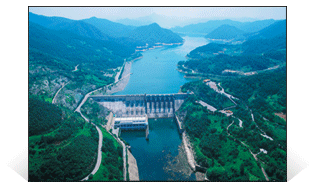Apparently, this is nothing new; according to the article, he first proposed the idea as a lawmaker in 1996. Why does he think this will work?
``The southern part of the Han River and the upper part of the Naktong River is only 20 kilometers apart. If we are able to connect Seoul and Pusan through an inner-country waterway, it will cut one-third of logistics costs and help the economy by creating more jobs and balancing regional development’’Sounds wonderful. Luckily, a few sane people have spoken up about this idea:
[C]ritics question whether building a massive canal connecting Seoul and Pusan will be economically reasonable. In a 1998 report jointly published by the Korea Water Resources Corporation (KWACO) and the Korea Research Institute for Human Settlements, the state-run organizations said that it would take more than 10 trillion won to build a canal connecting the Han River and Naktong River.Let's address the '62 hours' bit first. I took a ferry once from Incheon to Jeju. It took about 12 hours. The most I could imagine it taking to get to Busan would be 24 hours. So obviously, the canal would save so much time, wouldn't it? Perhaps Lee means to transport goods to inland cities, but there aren't many large ones on the route of the rivers, excepting Daegu.
The groups also questioned the canal’s efficiency as a transport route, saying it would take 62 hours by ship to move cargo up the canal from up to bottom and will need an additional supply of 22 million tons of water to sustain the connection.
Let's address, oh, say the following picture:
 The Chungju Dam, on the Namhan River, is 97.5 meters high. There's another dam 19 km downstream. There's also a 2km wide dam at the mouth of the Nakdong River. There are two dams on the Han River near the eastern and western boundaries of Seoul, which exist to keep the shallow river high enough for the sightseeing tour boats. According to this page, South Korea has 1,213 large dams, so I would imagine that there are many more dams on these two rivers. This would mean altering these dams to create locks. I can't help wonder if Hyundai Construction (Lee Myung-bak's old company) had anything to do with building these dams. He's already shown with Cheonggyecheon that he's quite good at spending a lot of money to undo projects carried out by his former company years ago. Suffice to say, it's not just a matter of digging a canal between the two rivers, but of building new dams, altering old ones, and carrying out massive dredging projects.
The Chungju Dam, on the Namhan River, is 97.5 meters high. There's another dam 19 km downstream. There's also a 2km wide dam at the mouth of the Nakdong River. There are two dams on the Han River near the eastern and western boundaries of Seoul, which exist to keep the shallow river high enough for the sightseeing tour boats. According to this page, South Korea has 1,213 large dams, so I would imagine that there are many more dams on these two rivers. This would mean altering these dams to create locks. I can't help wonder if Hyundai Construction (Lee Myung-bak's old company) had anything to do with building these dams. He's already shown with Cheonggyecheon that he's quite good at spending a lot of money to undo projects carried out by his former company years ago. Suffice to say, it's not just a matter of digging a canal between the two rivers, but of building new dams, altering old ones, and carrying out massive dredging projects.In an interview, he said "The Seoul-Busan Canal plan I announced during the 14th National Assembly is a comprehensive plan to foster national competitiveness and create jobs." Create jobs for who? What industry will benefit from such a huge construction project? He also said, "I went into a firm with 100 employees (Hyundai Construction) and made it into one with 160,000". A plan that will pour 10 trillion won into the construction industry, which happens to be his former industry - what a strange coincidence. Lamenting the fact that Korea does not use its rivers as transport routes, Lee said that "Korea uses its rivers as sewers". I wonder to what degree the actions of his old company played a role in the conversion of Korean rivers to 'sewers'.
It's worth noting that environmentalists opposed to unhindered dam building managed to stop dam building for 6 years, between 1996 and 2002 (though since then work has resumed, with the Peace Dam being finished this month). Much of it centered around opposition to the construction of the Yongwol dam, on the Dong river, in Kwangwon-do, the movement against which is described briefly here. Another article from 1999 mentions that "there are already seven dams within Kangwon, which have led to the displacement of 29,000 people in the past five decades." Considering these numbers refer to only one province, and the variety of dams described here, the effect dam construction has had upon people must be considerable. It's hard not to notice that environmental groups managed to halt projects in 1996, just 4 years after the first civilian government came to power. Under the dictatorships, people wouldn't have been able to complain much about the dislocation caused by dam construction.
One of the more insane projects that was halted only earlier this year is the Saemangeum reclamation project in Jeollabuk-do, where a 33km long sea-wall across the estuaries of the Mangyeung and Dongjin Rivers is almost finished construction. There's lots of information about it here, and relevant pictures are here.
